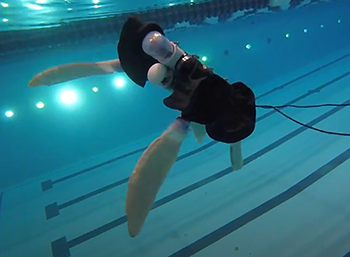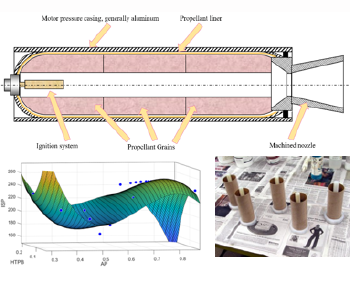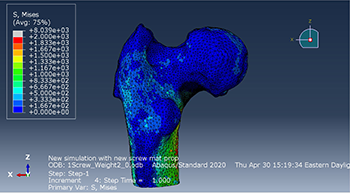MENG 472/474 Projects - Spring 2020
In MENG 472/474, students work on independent projects that cover a wide range of topics, from traditional mechanical engineering topics (e.g., mechanical device design, fluid flow, and materials analysis) to interdisciplinary topics at the interface between mechanical engineering and other branches of engineering such as biomedical, chemical, electrical, or environmental engineering. Under the supervision of faculty advisers, students investigate physical phenomena through experimental measurement and/or numerical simulation, and they design and construct functioning prototypes to solve engineering problems. The majority of the faculty advisers come from within the mechanical engineering department, with the remaining advisers distributed across the University (and occasionally outside the University). Funding for projects is generously provided by the Yale SEAS Dean's Office and, in some cases, through the faculty advisers. The students were asked to write the following short summaries two-thirds of the way through the semester, when they still had a few weeks to go on their projects. All projects are represented here, except for those that cannot be publicized due to information of a proprietary nature.
A Modular Water-Resistant Chassis for a Turtle Inspired Amphibious Robot
Andonny Garcia
Advisor: Prof. Rebecca Kramer-Bottiglio, Department of Mechanical Engineering & Materials Science
 Vehicles made for traveling on land or in water currently exist. Examples include cars for driving on roads, boats for traveling across bodies of water, submarines for exploring the depths of the ocean, and planes for flying above the surface of the earth. Yet very few vehicles are capable of traveling effectively in two modalities, for example both on land and in water. My research focused on a turtle-inspired robot, which is capable of both land and sea locomotion. In particular, my research optimized the chassis of the robot by making it more easily serviceable without sacrificing water resistance.
Vehicles made for traveling on land or in water currently exist. Examples include cars for driving on roads, boats for traveling across bodies of water, submarines for exploring the depths of the ocean, and planes for flying above the surface of the earth. Yet very few vehicles are capable of traveling effectively in two modalities, for example both on land and in water. My research focused on a turtle-inspired robot, which is capable of both land and sea locomotion. In particular, my research optimized the chassis of the robot by making it more easily serviceable without sacrificing water resistance.
Solid Rocket Motor Design: Theory and Formulation of an APCP Propellant with Simulated Motor Design
Alexander C.C. Hoganson
Adviser: Prof. Alessandro Gomez, Mechanical Engineering & Materials Science
 Ammonium perchlorate and hydroxyl-terminated polybutadiene are the primary components of solid propellants known as APCP used in rocket motors. While commonly used in both the professional rocket industry and among enthusiastic hobbyists, there currently exists no substantive literature that addresses the theoretically complex engineering theories and the technical applications of APCP propellants. This research project aims to fill that void by focusing on the transition between chemical propulsion theory and practice. The overall goal is to comprehensively explore and characterize the design, development, and simulation procedures for APCP rocket propellant and subsequent motor integration. The research initially combined RPA–C software and first principles and applied them to theorize the efficiencies of different propellant chemical compositions. Next, the research used MatLab graphing structures to theoretically optimize propellant composition. Then, research and curve fittings were performed to find burn rate exponent approximations for different propellants. Simultaneously, theories of chemical propulsion were used to design combustion chambers and optimized rocket nozzles. Finally, the data was iterated in BurnSim to produce optimized thrust curves for each propellant type. The analysis performed has verified the common use of aluminum and magnesium as energetic additives to APCP motors and produced a theoretically optimized formula for each.
Ammonium perchlorate and hydroxyl-terminated polybutadiene are the primary components of solid propellants known as APCP used in rocket motors. While commonly used in both the professional rocket industry and among enthusiastic hobbyists, there currently exists no substantive literature that addresses the theoretically complex engineering theories and the technical applications of APCP propellants. This research project aims to fill that void by focusing on the transition between chemical propulsion theory and practice. The overall goal is to comprehensively explore and characterize the design, development, and simulation procedures for APCP rocket propellant and subsequent motor integration. The research initially combined RPA–C software and first principles and applied them to theorize the efficiencies of different propellant chemical compositions. Next, the research used MatLab graphing structures to theoretically optimize propellant composition. Then, research and curve fittings were performed to find burn rate exponent approximations for different propellants. Simultaneously, theories of chemical propulsion were used to design combustion chambers and optimized rocket nozzles. Finally, the data was iterated in BurnSim to produce optimized thrust curves for each propellant type. The analysis performed has verified the common use of aluminum and magnesium as energetic additives to APCP motors and produced a theoretically optimized formula for each.
Orthopedic Implants as Prophylactic Intervention in the Hip
Brian Rhee
Advisors: Drs. Daniel Wiznia and Steven Tommasini, Yale School of Medicine
 Current medical technologies in the treatment of osteoporosis within geriatric patients are limited due to their long treatment time and potential side effects. This study explores if orthopedic implants, specifically cannulated hip screw implants, are a viable method in supporting the bone during regular "normal use" loading and mitigating fractures from sudden impacts and falls. This was done by creating finite element models from imported CT scans of geriatric patients in Simpleware ScanIP and simulating the aforementioned conditions in Abaqus/CAE. Although additional research and simulations are required, initial results suggest that cannulated hip screws are a potential solution that is effective and expeditious in treating osteoporosis of the femur.
Current medical technologies in the treatment of osteoporosis within geriatric patients are limited due to their long treatment time and potential side effects. This study explores if orthopedic implants, specifically cannulated hip screw implants, are a viable method in supporting the bone during regular "normal use" loading and mitigating fractures from sudden impacts and falls. This was done by creating finite element models from imported CT scans of geriatric patients in Simpleware ScanIP and simulating the aforementioned conditions in Abaqus/CAE. Although additional research and simulations are required, initial results suggest that cannulated hip screws are a potential solution that is effective and expeditious in treating osteoporosis of the femur.

